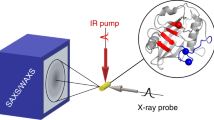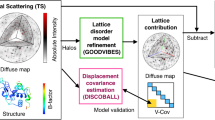Abstract
WHEN resting skeletal muscle is excited or goes into rigor, there is a characteristic change in the ratio of the intensities of the two principal equatorial reflections, I11/I10. This has been interpreted simply as reflecting movement or transfer of mass in the radial direction from the thick to thin filaments1,2. Other, higher orders, have, however, been observed1,3, and a more detailed interpretation is possible, which should eliminate some of the ambiguity that results from using only two reflections. Since there is considerable evidence that the myosin filament is actually three or four stranded4–6, rather than two stranded as originally proposed, reinterpretation is necessary. Further, studies of X-ray diagrams from muscle in the presence of ATP analogues suggest that at least in some cases, equatorial intensity ratios intermediate between rigor and relaxed do not arise from a mixture of those states, but rather from a state with different structural properties7–9.
This is a preview of subscription content, access via your institution
Access options
Subscribe to this journal
Receive 51 print issues and online access
$199.00 per year
only $3.90 per issue
Buy this article
- Purchase on Springer Link
- Instant access to full article PDF
Prices may be subject to local taxes which are calculated during checkout
Similar content being viewed by others
References
Huxley, H. E., J. molec. Biol., 37, 507–520 (1968).
Haselgrove, J. C., and Huxley, H. E., J. molec. Biol., 77, 549–568 (1973).
Elliot, G. F., Lowy, J., and Millman, B. M., J. molec. Biol., 25, 31–45 (1967).
Squire, J. M., J. molec. Biol., 72, 125–138 (1972).
Tregear, R. T., and Squire, J. M., J. molec. Biol., 77, 279–290 (1973).
Morimoto, K., and Harrington, W. F., J. molec. Biol., 83, 83–97 (1974).
Lymn, R. W., and Huxley, H. E., Cold Spring Harb. Symp. quant. Biol., 37, 449–453 (1973).
Goody, R. S., Holmes, K. C., Mannherz, H. G., Barrington Leigh, J., and Rosenbaum, G., Biophys. J., 15, 687–705 (1975).
Lymn, R. W., J. molec. Biol. (in the press).
Lowey, S., Slater, H. S., Weeds, A. G., and Baker, H., J. molec. Biol., 42, 1–29 (1969).
Bantz, D. A., and Zwick, M., Acta Crystallogr. A 30, 257–260 (1974).
Miller, A., and Tregear, R. T., J. molec. Biol., 70, 85–104 (1972).
Moore, P. B., Huxley, H. E., and DeRosier, D. J., J. molec. Biol., 50, 279–295 (1970).
Author information
Authors and Affiliations
Rights and permissions
About this article
Cite this article
LYMN, R. Equatorial X-ray reflections and cross arm movement in skeletal muscle. Nature 258, 770–772 (1975). https://doi.org/10.1038/258770a0
Received:
Accepted:
Issue Date:
DOI: https://doi.org/10.1038/258770a0
This article is cited by
-
Changes in thick filament structure during compression of the filament lattice in relaxed frog sartorius muscle
Journal of Muscle Research and Cell Motility (1989)
-
The interpretation of X-ray diffraction patterns from vertebrate striated muscle
Journal of Muscle Research and Cell Motility (1980)
-
Cross-bridge movement during muscle contraction
Nature (1976)
Comments
By submitting a comment you agree to abide by our Terms and Community Guidelines. If you find something abusive or that does not comply with our terms or guidelines please flag it as inappropriate.



